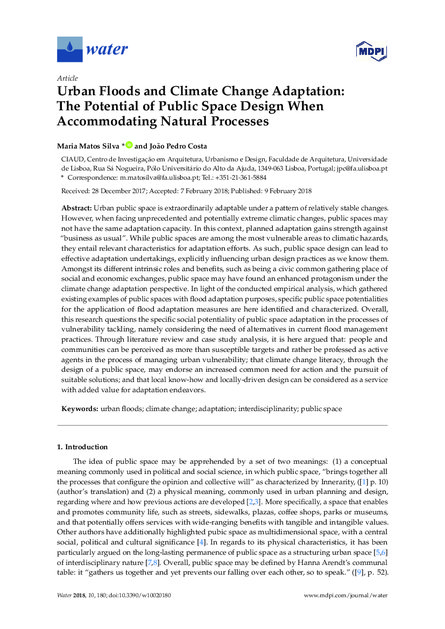
This paper examines existing examples of public spaces with flood adaptation purposes worldwide and identifies and analyses the potential for the application of flood adaptation measures in public spaces in general. Overall, this research questions the specific social potentiality of public space adaptation in the processes of tackling vulnerability, namely considering the need of alternatives in current flood management practices. Through literature review and case study analysis, it is here argued that:
- people and communities can be perceived as more than susceptible targets and rather be professed as active agents in the process of managing urban vulnerability;
- that climate change literacy, through the design of a public space, may endorse an increased common need for action and the pursuit of suitable solutions;
- and that local know-how and locally-driven design can be considered as a service with added value for adaptation endeavors.
Urban public space is extraordinarily adaptable under a pattern of relatively stable changes. However, when facing unprecedented and potentially extreme climatic changes, public spaces may not have the same adaptation capacity. In this context, planned adaptation gains strength against “business as usual”. While public spaces are among the most vulnerable areas to climatic hazards, they entail relevant characteristics for adaptation efforts. As such, public space design can lead to effective adaptation undertakings, explicitly influencing urban design practices as we know them. Amongst its different intrinsic roles and benefits, such as being a civic common gathering place of social and economic exchanges, public space may have found an enhanced protagonism under the climate change adaptation perspective.
Links
Resource collections
- Floods
- Learning from crises
- UN Habitat - Urban Response Collection
- Urban Response - Urban Crisis Preparedness and Risk Reduction
- Urban Response Collection - Community Engagement and Social Cohesion
- Urban Response Collection - Economic Recovery
- Urban Response Collection - Environment and Climate Change
- Urban Response Collection - Housing, Land and Property
- Urban Response Collection - Urban Crisis Response, Recovery and Reconstruction
- Urban Response Collection - Urban Resilience
